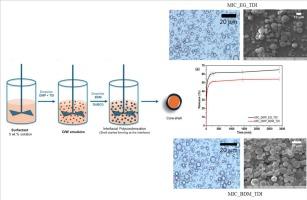芳香族二醇界面缩聚制备聚氨酯缓释微胶囊
IF 5.1
3区 工程技术
Q1 CHEMISTRY, APPLIED
引用次数: 0
摘要
通过界面聚合制备的聚氨酯(PUU)微胶囊由于其可调节的尺寸和膜厚度、高负载效率和可扩展性而引起了人们的极大兴趣。虽然一些芳香和脂肪族二醇和多元醇已被用于生产聚氨酯泡沫和薄膜,但由于芳香二醇在水中的溶解度有限,使用芳香二醇通过界面聚合来合成PUU MICs是一个未开发的领域。本报告重点介绍了用芳香二醇(苯-1,4-二甲醇,BDM)包封邻苯二甲酸二甲酯(DMP)的PUU微胶囊的成功制备。制备的PUU微胶囊包封效率高达92%,尺寸范围为1 ~ 20 μm。差示扫描量热(DSC)热图显示,与含有脂肪族二醇的PUU mic的108℃相比,其玻璃化转变温度(Tg)明显高143℃。释放研究证实,与脂肪族乙二醇基PUU mic相比,芳香二醇基mic具有更强的屏障特性,使用Weibull模型对释放曲线的解释表明,菲克扩散是DMP释放的主要机制。这些微胶囊可用于高性能应用,如复合材料、涂料、电子和建筑。本文章由计算机程序翻译,如有差异,请以英文原文为准。

Sustained release polyurethane microcapsules by interfacial polycondensation using aromatic diols
Polyurea-urethane (PUU) microcapsules prepared via interfacial polymerization have gained significant interest due to their tunable size and membrane thickness, high loading efficiency, and scalability. Although several aromatic and aliphatic diols and polyols have been used to produce PU foams and films, the use of aromatic diols to synthesize PUU MICs via interfacial polymerization is an unexplored domain due to the restricted solubility of aromatic diols in water. This report highlights the successful preparation of PUU microcapsules using an aromatic diol (benzene-1,4-dimethanol, BDM) to encapsulate dimethyl phthalate (DMP), a model insect repellent. The developed PUU microcapsules exhibited a high % encapsulation efficiency of 92 % and a size range of 1–20 μm. Differential scanning calorimetry (DSC) thermograms revealed a significantly high glass transition temperature (Tg) of 143 °C as compared to 108 °C in the case of PUU MICs with aliphatic diols. Release studies confirm enhanced barrier properties for aromatic diol-based MICs as compared to aliphatic ethylene glycol-based PUU MICs, and interpretation of the release profile using the Weibull Model reveals that Fickian diffusion is the dominant mechanism in the release of DMP. These microcapsules can be used in high-performance applications such as composites, coatings, electronics, and construction.
求助全文
通过发布文献求助,成功后即可免费获取论文全文。
去求助
来源期刊

Reactive & Functional Polymers
工程技术-高分子科学
CiteScore
8.90
自引率
5.90%
发文量
259
审稿时长
27 days
期刊介绍:
Reactive & Functional Polymers provides a forum to disseminate original ideas, concepts and developments in the science and technology of polymers with functional groups, which impart specific chemical reactivity or physical, chemical, structural, biological, and pharmacological functionality. The scope covers organic polymers, acting for instance as reagents, catalysts, templates, ion-exchangers, selective sorbents, chelating or antimicrobial agents, drug carriers, sensors, membranes, and hydrogels. This also includes reactive cross-linkable prepolymers and high-performance thermosetting polymers, natural or degradable polymers, conducting polymers, and porous polymers.
Original research articles must contain thorough molecular and material characterization data on synthesis of the above polymers in combination with their applications. Applications include but are not limited to catalysis, water or effluent treatment, separations and recovery, electronics and information storage, energy conversion, encapsulation, or adhesion.
 求助内容:
求助内容: 应助结果提醒方式:
应助结果提醒方式:


